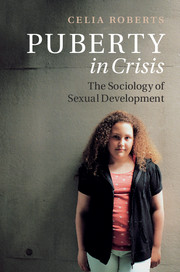Book contents
- Frontmatter
- Dedication
- Contents
- List of figures
- Acknowledgements
- 1 Puberty in crisis? Sex, reproduction and the loss of future
- 2 Articulating findings, feelings and figurations: methods and approaches
- 3 Telling histories: the scientific study of puberty
- 4 Defining early onset puberty: troubling findings about sexual development
- 5 Causes and explanations: genes, fat, toxins and families
- 6 Consequences of early development: sex, drugs and shortness
- 7 Treatments: pharmaceuticals, sex and suffering
- Conclusion: Folding puberty differently: changing findings, feeling and figurations
- References
- Index
2 - Articulating findings, feelings and figurations: methods and approaches
Published online by Cambridge University Press: 05 August 2015
- Frontmatter
- Dedication
- Contents
- List of figures
- Acknowledgements
- 1 Puberty in crisis? Sex, reproduction and the loss of future
- 2 Articulating findings, feelings and figurations: methods and approaches
- 3 Telling histories: the scientific study of puberty
- 4 Defining early onset puberty: troubling findings about sexual development
- 5 Causes and explanations: genes, fat, toxins and families
- 6 Consequences of early development: sex, drugs and shortness
- 7 Treatments: pharmaceuticals, sex and suffering
- Conclusion: Folding puberty differently: changing findings, feeling and figurations
- References
- Index
Summary
In contemporary medical textbooks and educational materials for young people, their families and their teachers, puberty is described as a series of predestined and largely inescapable biological processes involving the growth of breasts, testicles and pubic hair, changes in overall body shape and size, the deepening of voices, first experiences of nocturnal seminal emissions or menstruation. Separated from but also kick-starting the psycho-social elements of growing up normally referred to as adolescence, puberty is understood as the unfolding of dualistic physiological sexual maturity and the development of a capacity to reproduce (Roberts 2007: 69–72). As feminist theorist Catherine Driscoll notes, in puberty manuals for young people, teachers and parents, ‘The “facts” of puberty are cast in disciplinary terms, with those anomalies and variations that are named as acceptable marking limits beyond which difference is by default unacceptable or normal’ (Driscoll 2009: 235–6).
In contrast to this didactic emphasis on physical facts and norms, this book articulates puberty as a bio-psycho-social phenomenon, a different kind of folding process in which distinctions between the biological, the psychological and the social are continually blurred. Learning from feminist theory, science and technology studies (STS), sociology, history and cultural studies, I argue that bodies develop in and through social, historical and geographical ‘locations’ (meaning physical, psychological and social positioning). Studying pubertal bodies involves engaging with findings, feelings and figurations in relation, rather than simply accumulating and sorting biological facts. In this book, then, I am interested in scientific findings (including numerical and visual data, graphs, statistical trends and relations) but engage with these as always-in-process outcomes of particular forms of practice including experimentation, clinical practice, calculation, representation and publication. As I will explain, for me, the word ‘findings’ works better than ‘facts’ or ‘data’ to signal this sense of labour and contingency.
Like many contemporary feminists, I am also interested in feelings – what others call affect (see, for example, papers in Pedwell and Whitehead 2012). As described in the Introduction, puberty is an affective subject, with early sexual development provoking intense feelings of concern.
- Type
- Chapter
- Information
- Puberty in CrisisThe Sociology of Early Sexual Development, pp. 30 - 50Publisher: Cambridge University PressPrint publication year: 2015



